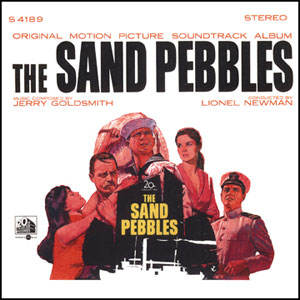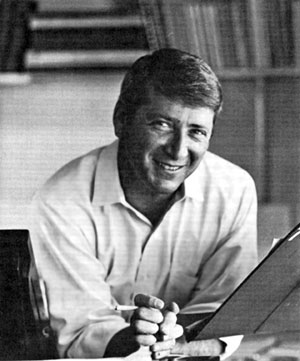

  |
|
|
||||||||||||||||||||||
|
FMS FEATURE... June 4, 2007 Goldsmith's Sand Pebbles Celebrated New details of classic score revealed by Jon Burlingame  This writer was privileged to be asked to contribute to the music-with-commentary track (along with producer Nick Redman and screenwriter Lem Dobbs). Weeks of research – including a review of Goldsmith's surviving sketches and all of the fully orchestrated scores – preceded the recording of that track in an effort to cover as much of the history of Goldsmith's contribution as possible. Along the way, we discovered a good deal of hitherto unknown detail and information that calls into question some previously held assumptions. By the time Jerry Goldsmith was signed to score The Sand Pebbles, he had already received two Oscar nominations (for Freud, 1963, and A Patch of Blue, 1965) and was considered one of Hollywood's hottest young composing talents. He was 37. "It's a favorite picture of mine," Goldsmith said in a 1988 interview for Canadian television. "It was also an accident that I did the picture." Alex North had already been set to write the music. He had scored such epics as Spartacus (1960) and, for Fox, Cleopatra (1963) and The Agony and the Ecstasy (1965). Fox musical director Lionel Newman, who had conducted much of Cleopatra for North, knew that the veteran composer would give director Robert Wise exactly what the picture needed: the requisite scope, plus the ethnic component that would indicate the time and place of the story (China in the 1920s). But as North was about to start the film, he developed a painful bout of sciatica that caused him to beg off the job. Privately, Goldsmith would later tell friends that he thought the film's violence put North off. But correspondence between North and Wise points only to the medical issue. Wise wrote that he was "equally sorry" that North could not contribute, and sent get-well wishes. The Hollywood Reporter announced North's illness on Aug. 25, 1966, and Goldsmith's signing on Aug. 31 with a note that "Goldsmith will begin working on the score this week." At the time, Goldsmith was under non-exclusive contract to Fox. During the previous two years, he had scored Rio Conchos, Von Ryan's Express, Our Man Flint and The Blue Max for the studio, so Newman knew he could handle the assignment. Plus, Goldsmith had written the prologue music for North's Agony and the Ecstasy, so the choice may have seemed an obvious one for Newman. Goldsmith was about to start Grand Prix for director John Frankenheimer at MGM, but Fox was able to "pre-empt" Goldsmith out of that picture – because of a clause in his Fox contract – and bring him back for Sand Pebbles. "I got a call at 5 o'clock saying I was going to do the picture," Goldsmith said in that television interview. "I remember I went into the studio at 8 o'clock that night to see the film. It was really the first big picture I did. Bob Wise was a little nervous about me doing it.... In those days this was a blockbuster picture. It cost 11 or 12 million dollars, and it was a bit controversial. It made quite an antiwar statement. We were embroiled in Vietnam then." Goldsmith worked on the film for a little over three months, and wrote between 70 and 80 minutes of music. (By comparison, many composers today are lucky to get four weeks for that much music, and often even less.) "I loved Bob Wise immediately," Goldsmith said. "He was wonderful to work with because he knew, dramatically, what worked and what didn't work. He's very precise in what he wants and where he wants the music. It was a great learning experience for me."  Jerry Goldsmith in the mid-1960s. The tune, expanded into song form with a lyric by Leslie Bricusse, became known as "And We Were Lovers." Never sung in the movie, or even included as a vocal on the soundtrack album, it eventually generated about 30 records, including vocals by Andy Williams, Jack Jones and Shirley Bassey. Had there been a place for it in the film, it probably would have received an Oscar nomination. The Chinese theme is most often associated with Richard Attenborough (as Frenchy Burgoyne) and Marayat Andriane (Maily) but, again, it is not solely their love theme, as it arises in other contexts involving the Chinese people. It is interesting to note that this theme actually originated in Goldsmith's score for a 1959 Perry Mason episode ("The Case of the Blushing Pearls," guest-starring a pre-Star Trek George Takei), which dealt with a young Japanese girl accused of murder. There are secondary motives such as the decisive, five-note Chinese theme that basically represents mainland China and the threat its army poses to the American gunboat (the "San Pablo") and its personnel. There is also a melancholy motif associated with the violent deaths of characters including Po-han (Mako) and later the Chinese student whom Holman kills with his ax after the gunboat battle. Newman conducted the music – as he did for almost every Fox film at the time – which was recorded piecemeal over two months. There were eight sessions (Oct. 6, 13, 14, 28; Nov. 10, 11, 21; Dec. 7), with an orchestra that ranged from 14 musicians to, at its height, 76 musicians, with the legendary Louis Kaufman as concertmaster. Kaufman's Hollywood history dated back to the mid-1930s at Goldwyn, MGM and Fox, and he often served as violin soloist on Goldsmith scores (notably, later, on The Mephisto Waltz). It was Kaufman who first introduced Vivaldi's The Four Seasons to America, via an acclaimed 1947 recording. There are also two instances of Chinese music attributed to Earle Hagen, the television-music pioneer who at the time was scoring I Spy, which had many episodes set in the Far East. They are each about a minute long and serve as "source music" for outdoor scenes. Asked about this, Hagen explained: "The two pieces of music were tracks that I got in Hong Kong. Fox needed some ethnic music and asked if they could use some of mine.... I didn't write them or have anything to do with them other than buying them in Hong Kong." The Sand Pebbles was a major assignment for Goldsmith. He recalled it in interviews as his first 70mm, six-track stereo film. Actually, The Blue Max came first, also for Fox, but that film failed at the box office (although its score is still rightly regarded as one of the composer's 1960s triumphs). The Sand Pebbles was a huge success, with multiple Oscar nominations (including one for Goldsmith), so it's not surprising that he remembered that one as his first roadshow picture. There was a much higher level of showmanship involved with the roadshow films of that era than we see in movie exhibition today. Musically speaking, they often featured an overture, entr'acte music for the intermission, and exit music. Goldsmith actually wrote two overtures for The Sand Pebbles. The first focused primarily on the "Chinese love theme," and that appeared on the original soundtrack album. But between the time it was recorded and the end of the last session, someone decided – and it might have been Wise, or Newman – that the overture should feature Goldsmith's other love theme, "And We Were Lovers," so orchestrator David Tamkin reworked the overture, and that is the one that accompanied the film (it is labeled "overture (new)" on the surviving orchestrations, although it is not dated). Tamkin, a Russian-born composer who often worked with Dimitri Tiomkin, had orchestrated Lonely Are the Brave and Stagecoach for Goldsmith. Fox music logs indicate that Arthur Morton – who had done The Blue Max in London with Goldsmith and who would later become Goldsmith's regular orchestrator – was already booked, composing multiple episodes of the studio's popular Peyton Place television series throughout the fall of 1966. The so-called "exit music" is a different story. 20th Century-Fox Records was not only planning to release the soundtrack, but had planned a 45 rpm single in an effort to procure radio play of the theme. So the first cut on side 2 of the LP is the "exit music," a radio-friendly arrangement of "And We Were Lovers," written by arranger Warren Barker (perhaps best-known for creating the nose-twitching music on Bewitched). That also became the A-side of the single. Barker did another arrangement for the flip side, a version of the "Chinese love theme," but although recorded, it was not used (a truncated version of Goldsmith's original overture appeared instead). It surfaced only recently, on the 2002 Varese Sarabande "deluxe edition" CD. Yet another arrangement of "And We Were Lovers," written at Newman's behest by veteran big-band composer Billy May – who was then on the Fox lot composing music for The Green Hornet – went unrecorded. Neither Goldsmith nor Tamkin were involved in any of these attempts to popularize the music. "The film was a lot of work. It was tough," Goldsmith recalled. "It was done with surgical precision, I would say. There was a lot of time to do the picture, and a lot of stuff I had to go back and rewrite because it wasn't right." Goldsmith's original sketches indicate that several cues were rewritten, and some were ultimately dropped from the film. Cues in reel 5 ("Trial Run"), reel 13 ("Not in Vain"), reel 23 ("Final Mission" and "Fire Aft") and reel 26 ("Almost Home, part II") are labeled "new," "revised," or "new version." One of the most fascinating aspects of the Sand Pebbles score is Goldsmith's ability to create sounds that, to our Western ears, seem authentic. The composer utilized a battery of traditional Oriental instruments, along with unusual percussion instruments from around the world, all designed to evoke the right mood. He used angklungs, which are perhaps best described as bamboo slide rattles; the Indonesian gamelan, pitched percussion instruments; crotales, tuned metal discs; Chinese temple bells; wood drums; and, surprisingly, European instruments including the cimbalum and mandolin, which we do not associate with Asia yet which help in establishing the exotic atmosphere. There is also a harpsichord, notably in the sequence Goldsmith called "Restless Months," as the San Pablo sat in the river during the winter. And, of course, gongs, chimes and other sounds that Westerners tend to associate with the Far East. Goldsmith failed to win the Oscar; the 1966 Academy Award went to John Barry, whose Born Free was a popular chart hit at the time. Goldsmith went on to score several other films set in the Orient including, for Fox, The Chairman (1969), Tora! Tora! Tora! (1970) and the TV series Anna and the King (1972). Later came Inchon and The Challenge (both 1982), Rambo (1985) and the film that brought Goldsmith his final Oscar nomination, Disney's Mulan (1998), set in ancient China. Goldsmith incorporated elements of The Sand Pebbles music into his "Motion Picture Medley" that he performed in concert for many years. "And We Were Lovers" was among his most successful themes from a commercial standpoint ("it's become a standard," he proudly told Canadian TV). And the score itself remains among his finest works, one happily revisited, and celebrated, on the new DVD. ©2007 Jon Burlingame |
Search
Past Features
Feature Archives
|